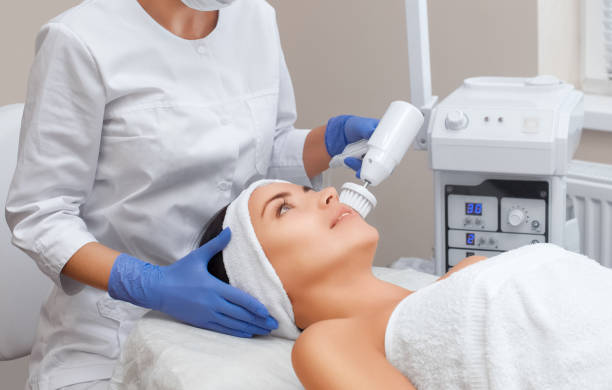The use of lasers and intense pulsed light sources (IPLS) is being considered to treat a variety of pigmentary diseases. They are sometimes regarded as magic instruments that can eliminate any lesions. Although they’re the best choice for various hyperpigmented lesions, they can also cause more ailments and may cause side effects.
Objective
This review aimed to provide evidence-based guidelines for using lasers and IPLS to treat hyperpigmented lesions.
Methods
These guidelines were developed by the European Society of Laser Dermatology by a panel of consensus comprising specialists in the area of laser pigmentation surgery. Recommendations on the use of lasers and light treatments were made based on the quality of evidence for efficacy, safety, tolerability, cosmetic outcome, patient satisfaction/preference, and, where appropriate, on the experts’ opinions.
Results
Lasers and IPLS are highly efficient in treating a variety of hyperpigmented lesions like dermal hyper melanocytosis, lentigos, or heavy depositions of metal. However, they should be taken into consideration with extreme caution when treating other diseases like macules of cafe au lait and melasma or postinflammatory hyperpigmentation. Once the proper diagnosis has been made, If the use of lasers or IPLS is required, the most appropriate wavelengths and parameters will be determined considering the phototype of the skin, its source, and the depth of pigments that are targeted.
Conclusion
While potentially efficient, lasers and IPLS are not viable options for the majority of hyperpigmented lesions. In all instances, accurate identification of the problem is essential to determine the best choice between these options and other treatments.
Introduction
The skin’s color is due to its pigments within the epidermis as well as in the dermis. The melanins (eumelanin, dark brown, produced chiefly by skin types with dark complexions, and Pheomelanin, a red-fair brown color that is mainly seen on fair-skinned kinds) are the primary pigments that humans have in their skin. However, other pigments from the body, like bilirubin and hemoglobin, are also involved in the color of teguments. Pigmentary conditions are one of the more common skin diseases and have been found as high as 60% of people in specific populations. 1 They are either acquired or passed down through the generations and are caused by darkening lightning or the unusual color of the skin. Quality or quantitative deficiencies in the production process or in the formation of melanin are the leading cause of the disorders that affect pigmentation. But, irregularities in other pigments from the endogenous as well as the deposition of exogenous pigments can also cause dyschromic lesions. The pathophysiological factors that contribute to these disorders of pigmentation, the locations of the stains within the skin, and the types that are correlated with chromophores segregated must be considered prior to recommending a treatment approach in general and for specific laser treatments (Fig. 1).2
Figure 1. View in Figure View PowerPointFlow chart on the treatment approach for the case of pigmentary disorders. Based on [Thierry Passeron, 2015, 2The Thierry Passeron 2015 2
Methods
Literature reviews were conducted from 1983 until April 2018 (see Appendix S1 Additional Information for more detailed search strategies). In the end, the search resulted in 8661 hits. After that, 981 cases and clinical studies, as well as observational research randomized controlled trials and systematic reviews, were screened and analyzed. Articles that contained only abstracts were left out. The list was subsequently augmented with a variety of articles following an examination of the references on the papers that were selected. The documents were analyzed by people who comprised the Consensus Panel (TP, RG, LS, TF, GK, HJL, LM, AB). The goal was to answer the following questions about every hyper pigmentary disorder based on the evidence available: (i) which lasers and light sources are recommended to treat it? (ii) What is the most effective therapeutic efficacy, and how was it evaluated? (iii) Are there any comparison studies of different light sources and lasers specifically for this issue? (iv) What are the side effects associated with the therapy? Then the draft was distributed to all members of the Panel who debated the content as well as made corrections and comments. The Panel held several discussions until a consensus was reached. When there were any clinical studies of high quality available, the expert opinions of all members of the Consensus Panel were taken into consideration. A final meeting of the Consensus Panel was later held to review all suggestions.
Lasers for disorders of the pigment
Different types of lasers are available to treat lesions that are pigmented. The majority of the lasers used for this purpose have been developed based on the idea of photo thermolysis selective. 3 Thus, the most effective wavelengths focus on the pigment (in the majority of instances, melanins) with minimal absorption by hemoglobin or even water. To achieve a selective effect on the part of the laser duration of the pulse must be ten times shorter compared to the time to thermal relaxation of the desired. Melanosomes with melanins are the primary lesion that causes most hyperpigmented disorders. Their size is approximately 0.5 millimeters, resulting in 1 to 10 milliseconds of relaxation. The ideal pulse duration must be less than 100 nanoseconds. Therefore, most lasers used to treat hyperpigmented lesions are Q-switched (QS), which allows such short pulse durations. The most commonly used lasers that are pigmented include the 694-nm Q-switched Ruby laser (QSRL) as well as the 755 nm Q-switched alexandrite laser (QSAL) as well as the 1064 nanometer and 532nm Lasers that are Q-switched to Nd: YAG (QSNY). The 511 nm copper-bromide laser has also been proposed to treat disorders of the pigmentary system. Although it’s not the most effective laser for treating vessels and pigmentation, the 595 nm pulsed dye laser (PDL) that has a compression handpiece to reduce the hemoglobin target could also be used to treat the pigmented lesion. 4 More recently, the use of picosecond lasers has been created to treat tattoos. A few case reports and research studies highlighted their importance in treating pigmentary diseases. Intense pulsed lights (IPLS) with filters that allow target lesions with pigmentation can be employed.
Although they are not selective, lasers that target the water chromophore (used in full beam or fractional mode) include the non-ablative 1550 nm Erbium-Glass laser as well as the ablative 2940 nanometer Erbium: YAG laser, the 600-nm carbon dioxide (CO 2) laser and the more recent 1927 nm thulium light source can alternatively be employed in particular conditions to vaporize the lesions, or for increasing the effectiveness into the skin of agents depigmenting.
Clinical indications
Hyperpigmentation caused by Melanin
Actinic Lentigos
Extended and unprotected sun exposure can cause benign spots of hyperpigmentation. Also, that is known as actinic lentigines. 5, 6, These localized forms of benign smooth, uniformly acquired hyperpigmentations are darker than those of ephelides and don’t get darker or grow in size when exposed to the sun. They are usually greater (>=1 millimeter) than the normal lentigines (2-5 millimeters in diameter). The differential diagnosis is lentigo maligna or pigmented actinic skin keratosis, flat seborrhoeic keratosis that is pigmented, and lichen planus-like keratosis. The correct diagnosis is crucial prior to starting treatment since it is often difficult to distinguish benign and malignant lesions, even among the best knowledgeable dermatologists. If you are unsure what is present, a biopsy of the suspected component is essential to rule out the possibility of malignant lentigo. 7
Removal of AL is frequently requested by patients. Systematic usage of sunscreens with high SPF as well as avoiding sunlight exposure during hours of intense radiation as well as regular cleansing of the skin and the epidermal barrier adequately protected maintenance can delay the appearance of new lesions that are pigmented and could lead to an immediate regression of existing ones. The treatment options for actinic lentigines can be classified into two major types: photochemical and topical treatments with specific actives.8 Photochemical treatments comprise cryotherapy, lasers, intense pulsed lights, and chemical peels.9-12 The topical application of particular actives targets the inhibition of melanin production, blocking melanocyte biostimulation as well as reducing melanin transfer to the final accepting cells, but not without side effects.13 14, 14 It is currently demonstrated that laser treatments are more effective than treatments for the skin or liquid nitrogen to treat acting lentigo.15 16, 16
Laser and Light Treatment
Diverse laser and IPLS techniques can be utilized as a stand-alone treatment or in conjunction with other treatments to improve the clinical side of AL. The treatment strategies must be developed based on skin type, as well as the reactive, extrinsic pigmentary changes caused by chronic or acute environmental exposure. Two broad kinds of devices could be chosen based on the following ultrashort nano/picosecond devices as well as long-pulsed (LP) devices. Ultrashort 532-694 and 755 lasers of nmQS specifically destroy melanosomes inside melanocytes and keratinocytes while limiting “collateral thermal damage” to non-involved peripheral tissue using the concept of selective photothermolysis. 3 The frequency of the fluorescence should be kept to a minimum in skin types with darker complexions to minimize the chance of developing post-inflammatory hyperpigmentation (PIH). 17, 18 Mild circular epidermal whitening with no immediate peripheral purpura can be considered an acceptable treatment goal even if micro purpura is seen within 1-2 minutes. Light systems for LP, like 595nm PDL and 755-nm lasers and IPLS, operate on the basis of more advanced theories of selective photothermolysis micro-amplifying the collateral effects of photothermal to non-photo-absorptive biological tissues. 4, 19, 20 Recently, Ultrashort Pulsed and IPLS were successfully combined in the same treatment session, significantly improving clinical outcomes, which suggests the benefits of combining strategies. 21
Recommendation
Actinic lentigos are a good indicator for ultrashort QS ns/ps lasers treating a small number of lesions. A couple of sessions are usually required for the complete removal of the lesions.
Lentigo simplex and Lentiginosis
Lentigines range from light to dark brown macules that are light to dark brown. They have diameters ranging from 1 millimeter to several centimeters. They usually appear in the early years of childhood, but they can occur at any time. Nail and mucosal lentigines tend to be more prevalent in skin types with darker complexions. Lentigines may also be passed down as part of a genetic condition like LEOPARD or Peutz-Jeghers Syndrome, or Carney complex. They typically occur on the skin that is exposed and, consequently, cause aesthetic issues in a lot of patients. However, it’s essential to rule out a causal relationship before beginning treatment. Treatment options in that scenario include topical lightening agents for skin and cryotherapy, chemical peels, as well as laser and light devices.
LIGHT TREATMENT and LASER
Numerous controlled, randomized trials using blinded observers comparing the sides treated with lasers against those treated with traditional therapy or using other forms of lasers and light therapy were conducted to test treatments using lentigo. 15, 2222 – 26, The studies showed positive results, with the lowest rate of recurrence, particularly when compared with the treatment of spots caused by cafe au lait. 27 QS lasers, such as QSNY, QSAL, and QS ruby, have the benefit of targeting melanin by their nanosecond-long pulses, which is why they are highly effective for treating lentigines. However, LP alexandrite, PDL, LP Nd: YAG, ablative lasers as well as IPLS have been tried and have been used with mixed results. Additionally, a brand newly developed 600-nm YAG laser was created specifically designed for this particular purpose in a bid to reduce the risk of skin hyperpigmentation, as well as damage from superficial vessels. However, the results of one randomized controlled study failed to reveal any significant differences. 28 Quasi-continuous lasers can also be helpful as a second option for treating pigmented lesions. They must be utilized with caution for dark skin types due to the greater risk of complications risk.26 29, 26 Performing cryotherapy before laser therapy could result in positive results; however, we do not recommend it as a first-line treatment for those with dark skin because of their hyperpigmentation risk.10 Its 595nm PDL can be effective in treating lentigines with the compression handpiece to reduce the chance of purpura.30 31 Another beneficial alternative A second option, IPLS, has proven effective in treating superficial lesions that are pigmented. The effect is primarily broad and shallow, causing a gradual, uniform epidermal injury sparing the deeper layers. Low-intensity pulses must be used to stop the development of epidermal wounds that are not targeted. If these steps were taken, it would be possible to achieve a 50 percent or more reduction in pigmentation without adverse effects. 32, 33
Table S1 (Supporting Information) provides a summary of the information available for the laser treatment of lentigos.
Recommendation
Lentigos simplex is a great indicator to look for lasers with QS. If there are a lot of lentigos, it’s imperative to identify a syndromic link prior to pursuing treatment.
Ephelides
Freckles, also known as Ephelides, are tiny macules that have pigmented, with well-defined but uneven borders that are generally reddish or light brown in color. 34 They tend to be evenly distributed in their size. They’re most visible after exposure to the sun and usually fade in the winter months after the sun’s exposure ceases. 35, 36 Freckles typically appear on the neck, face, as well as the chest and arms. They first appear in the early years of childhood. Fade with time and are typically seen among fair people, particularly those with blonde or red hair. 37 It is crucial to emphasize the frequent use of sunscreens that can hinder their growth significantly. It is essential to keep the effects of removing freckles after treatment. Chemical bleaching creams for topical use, peeling, and laser removal were all tried.
LIGHT TREATMENT and LASER
Freckles can be attributed to the MC1R gene variant that has reduced function, which results in the production of Pheomelanin instead of eumelanin. 38 Because the absorption curve for Pheomelanin is shifted to the left when compared to eumelanin. 532 nm wavelength is the most effective wavelength for targeting freckles. The most effective treatments of freckles include Pulsed pigmented lasers. QS lasers have been acknowledged as effective in the treatment of freckles. They are the preferred treatment for patients with light skin tone, with a minimum of complications. But, the LP lasers, due to their millisecond pulse widths, have been proven to be equally effective for dark-skinned people with a lower chance of developing PIH compared to QS devices. 23, 39 Many melanin-specific, as well as non-selective and selective lasers and IPLS, have been used for the removal of freckles. 20, 23, 29, 32, 39 – 43 In addition, bipolar radiofrequency and optical energy synergy using light has been explored to great success. 44 Different studies yielded different results, summarized in Table S2 (Supporting Information). However, recurrence of freckles can likely occur, making lasers a temporary and, therefore, not a great option.
Recommendation
Due to their large concentration of pheomelanins, Ephelides are best treated using 532 Nm QS lasers. The improvements are transient and require continuous repeating. Regular application of sunscreens is advised.




